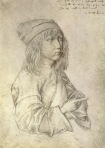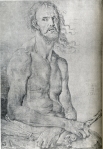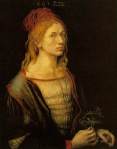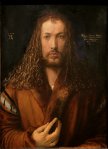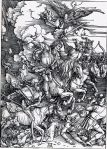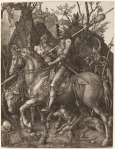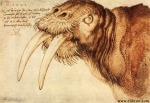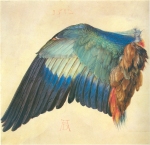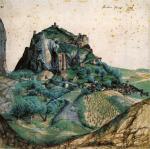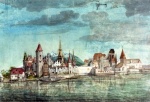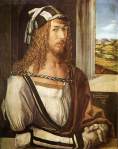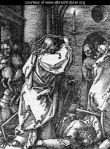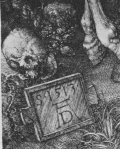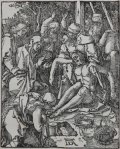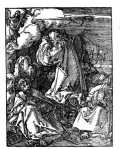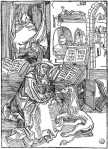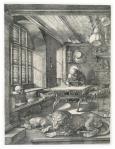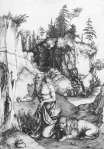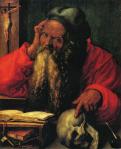
Ted Hughes: 14 Poems from "Crow" (new episode) – Human Voices Wake Us
Entries in the Anthology series organize my favorite anecdotes about artists, writers, and historical events, and are always being updated. While I love and depend on the exhaustive biography or study, in many ways the disconnected stories and fragments have been more important in my day-to-day living with art, literature and history. As such, nothing original is assumed here, and nearly everything in these pieces is built either on quotations from the historical personages themselves, or from the scholars who have written about them.
[1] At age fifty-three, and by then long famous, the German artist Albrecht Dürer (1471-1528) wrote of his early life this way: “And my father took special pleasure in me because he saw that I was diligent in striving to learn. So he sent me to the school, and when I had learnt to read and write he took me away from it, and taught me the goldsmith’s craft. But when I could work neatly my liking drew me rather to painting than to the goldsmith’s work, so I laid it before my father; but he was not well pleased, regretting the time lost while I had been learning to be a goldsmith.”
Dürer’s training as a goldsmith, however, was far from the waste his father imagined. Smith writes: “His practice using such metal-cutting tools as a lozenge-tipped burin prepared him to make copper engravings a few years later. The experience also taught Dürer to think three-dimensionally.”
[2] While still studying with his father to be a goldsmith, Dürer executed a self-portrait of himself in silverpoint, at age thirteen. An inscription added to the picture in the 1520s assures the viewer that it was “fashioned after myself out of a mirror in the year 1484, when I was still a child.” As Smith notes, the young artist “looks away from the viewer as though to mask his dependence on the mirror … [and he] conveniently hides his right or drawing hand behind the folds of his sleeves.”
More importantly, and as a sign already of Dürer’s confidence, is the fact that work done in silverpoint cannot be erased. And more important still are Smith’s words that, while today we are long accustomed to an artist charting his career through a series of self-portraits, in 1484 “there were virtually no self-portraits by German artists, excluding a few busts of master builders adorning the walls of their churches and the rare inclusion of a painter’s face amid a crowd in an altarpiece scene…. [Dürer’s self-portrait] stands out as one of the earliest (one hesitates to say the first) known independent self-portraits by a German artist.”
So I think of the day, the hour, the atmosphere in the house, and the noises in the street, when a thirteen year-old did this strange first thing for a German artist to do. And then I reflect on the face in all of his subsequent, and no less distinct, self-portraits, down to one of the last, 1522’s Self-Portrait as a Man of Sorrows, sickly and sagging.
[3] Dürer apprenticed under the artist Michael Wolgemut, and Smith compares the latter’s pedestrian Portrait of a Young Man, and Dürer’s 1493 Self-Portrait as a stunning illustration of “how quickly Dürer surpassed his master.” I’ve heard it said of some of Picasso’s portraits, “I wouldn’t want to meet that person, but I like that picture,” and my reaction to Dürer’s 1493 likeness is something similar. While, as Smith says, Dürer “clearly delights in his own appearance,” that very appearance is not meant, it seems, to be attractive in the manner of portraits of the politically or religiously power. Dürer is always the artist, the maker with real hands, and always depicted with a “disconcertingly believable physical presence.” The picture is inviting, but the prospect of meeting the person is not.
This talent of course extended to his portraits of others. In 1525, the philosopher Erasmus wrote that he had received Dürer’s portraits of a mutual friend, Willibald Pirckheimer, and that he decorated his room with these, “so that wherever I turn I am seen by the eyes of Willibald.”
[4] Smith also points to Dürer’s portraits of his wife, such as the simple My Agnes, as also being unprecedented for the period, and looking ahead to the “unguarded” moments caught by Rembrandt’s sketches of his wife, Saskia.
[5] Zeuxis was an artist in ancient Greece, but little of his work survives other than colorful anecdotes. In one, he apparently painted grapes so convincingly birds tried to pick at them.
For his part, stories from Dürer’s friends circulated that his dog licked the famous 1500 Self-Portrait, so true was it to the master’s likeness.
Similar stories are told of the Greek artist Apelles, and in reference to his engravings, Erasmus called Dürer the “Apelles of the black lines,” writing that Dürer surpassed the Greek by being able to depict “shade, light, radiance, projections, depressions…. fire; rays of light; thunderstorms; sheet lightning; thunderbolts; or even, as the phrase goes, the clouds upon a wall; [and] characters and emotions” using only black lines.
While such comparisons are beyond my knowledge, I realize that I do look at Dürer’s engravings and woodcuts with the same fascination as Bernini’s statues, wondering how a human hand can do so much with so little, or with something so basic as stone, or black lines. For Dürer there are foregrounds with multiple landscapes and cityscapes behind them (Samson and the Lion), his astounding woodcut of a rhinoceros that needed no background, and there are scenes which seem to blend the two, impossibly complicated and crowded and muscular foregrounds with only a hint of background, as in the weighty and terrifying Four Horsemen, or Knight, Death and the Devil, all of which do indeed arise simply from the use of lines and empty space.
[6] Yet Dürer obviously also spent his life with color, as his watercolors and sketches of the natural and animal world attest: his Walrus, Hare, The Large Piece of Turf, and the companions Dead Blue Roller and Wing of a Blue Roller, among others.
And there are others before these: between October, 1494 and May, 1495, Dürer traveled to Italy for the first time, ending up in Venice. The four-hundred thirty-mile trip, apparently taken because of an outbreak of plague in Nuremberg, could last as long as two weeks, and Dürer used the time to do a series of watercolor landscapes. Smith notes that Dürer would have first been exposed to city- and landscape art at Wolgemut’s shop, where detailed cityscapes (even birds-eye-views) were commissioned, or where specific landscapes or cities were placed in the background of religious scenes.
However, as with Dürer’s earliest self-portrait, there is no religious or political or civic context to his watercolors. Smith again notes a first, in that “there is no obvious Northern European precedent for this exquisite scene” (View of Innsbruck), and that “no earlier artist is known to have sketched outdoors with watercolours.”
Smith writes that Dürer’s approach to these watercolors may have simply been based on “the amount of time available before he and his party moved on.” So again we can imagine a scene, a caravan, the bustle, and the artist simply among them, painting quickly or slowly, depending on the rhythm of others.
[7] Dürer’s earliest use of his famous AD monogram come in his 1498 Self-Portrait, with the note that the painting was executed when he was twenty-six. And from its first use here, looking “anchored” to the wall, the monogram became a character of sorts in his paintings and engravings: it later appears chiseled into a stone on which Christ is sitting; or the letters hang sign-like from a tree; or they “rest on the ground or are propped up on various surfaces”; in his Christ Cleansing the Temple, “the monogram, like the adjacent table, has been knocked over and partially falls out of the scene,” and in his depiction of the Garden of Gethsemane, the monogram is shown in the shade, as if it were as tired as St. Peter.
And on and on. If Dürer has a serious sense of his own genius, and his own personality, it happily seems to have been coupled with a good sense of humor and play.
[8] In 1498, Dürer paid for and published the book, Apocalypse, his illustrations alongside the text of the Book of Revelation. It is “the oldest known book printed by an artist at his own initiative.” Inspired by Wolgemut’s Nuremberg Chronicle, Smith notes important differences: Nuremberg Chronicle contained work by many artists, but Dürer’s book contained only his own; and while the Nuremberg Chronicle was taken on when Wolgemut was old and established, Dürer attempted (and succeeded) with the same gesture at the very beginning of his career.
[9] In his woodcut of the Martyrdom of St. John, Dürer dresses the Roman Emperor Domitian in Ottoman dress; and in his Pilate Washing His Hands, Pontius Pilate is also given Ottoman dress, much as Bosch and others used Ottoman and Muslim motifs in their depictions of the crucifixion of Christ, an anachronism in all ways that made its contemporary point.
[10] For his 1504 engraving Adam and Eve (The Fall of Man), Dürer modeled his First Couple on Classical sculptures, and this story is common enough: the Classical Greek original, prior to being lost, was copied by the Romans, and the Roman copy (sometimes only after being discovered and dug out of the ground) was utilized by Italian artists, and thereafter by anyone who saw copies or prints, or who could make a trip to Italy themselves (as Dürer had been lucky enough to do)
Dürer also used Classical models when depicting Jesus, and was unapologetic in explaining why: “As they used the most beautiful human proportions for their idol Apollo, so should we use those same proportions for Christ our Lord, the most beautiful in the world. And as they used Venus to express the most sublime beauty, we should depict the same elegant and refined figure of the purest Virgin Mary, the Mother of God. And out of Hercules we should make Samson, and we should do the same with all the others.”
In this way, Jordan Kantor’s comparison of the depictions of the Passion of Christ to jazz standard—a kind of stock scene which could be redone many different ways—widens out to the entire history of art, to all figures, gestures, landscapes, symbols, and the rest. Not only a standard scene, whatever it might be, but the standard idea of a scene at all, a human figure at all, a landscape or cityscape at all. And we can see it at play also just in Dürer’s handling of the theme of St. Jerome, sometimes accompanied by a lion, studying and translating and writing.
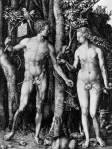
[11] For a year beginning in July 1520, Dürer and his family toured the Netherlands as honored guests, and he came away with a great stock of foreign art and objects.
Like Rembrandt’s house, found cluttered with curiosities and oddities after his death, Dürer collected everything. Smith writes that Dürer took in “anything from south Asia and possibly the Portuguese ports of trade in Africa. This includes a wooden weapon, feathers, cocoanuts, nuts, two ivory salt-cellars, silk clothing, the round shield covered with fish skins and two gloves… an old Turkish whip, Turkish cloth and Moroccan leather. Dürer delighted in nature’s artistry as he amassed veined shells, branches of coral, an elk’s foot, lots of horns, a sprouting bulb from Zeeland, a musk-ball from a musk-deer, a snail’s shell, porpoise-bristle brushes, perhaps a dried octopus, a possible living tortoise and a large turtle shell,” and so on.
[12] The ego of someone like Dürer must at times have been prodigious (in his 1500 Self-Portrait, after all, he gives himself the look of Jesus). In 1512 and 1513, he tried to compose a sort of handbook for young artists; not surprisingly, he considered sight “the noblest sense of man,” and was able with all ease to pronounce that Germany possessed “many painters who stand in need of instruction, for they lack all real art”—although thankfully the rest of that sentence allows that “they nevertheless have many great works to make.”
Yet Dürer was clearly able to realize his own limitations. Smith says this about Dürer’s preparations for his great Adam and Eve engraving: “The idea that there might be a rational mathematical basis for defining the human body fascinated Dürer during the early 1500s, even though he soon recognized the theory’s inherent limitations in the face of humanity’s infinite variability.”
And in a later work, Four Books of Human Proportions, which was published six months after his death on October 31, 1528, Dürer prefaced the whole by saying, “No one need blindly follow this theory of mine, as though it were quite perfect, for human nature has not yet so far degenerated, that another man cannot discover something better.”
Philipp Melanchthon, the great collaborator of Martin Luther’s, was also a close friend of Dürer’s, and had this to say about his friend in old age: “[Dürer said] that in his youth he loved paintings with lively and sparkling colors, and he enchanted an admirer of his works with the marvelous variety of his palette. Later, as an old man, he began to look closely at nature, and attempted to convey its actual appearance; in the process he realized that it was precisely this same simplicity which was the greatest achievement of art. Since he could not reach it he had, as he said, ceased to admire his own work but often sighed, when he looked at his paintings, and thought of his own weaknesses.”
This reminds me of a late remark by Thomas Aquinas who declared, after having a particularly astounding mystical experience (and after having spent a lifetime writing mountains of theological work), “All that I have written seems like straw compared to what has now been revealed to me.” I wish sometimes that the young (or even middle-aged) could take the ideas like these, of old artists and mystics and thinkers, as seriously as they do the energized proclamations of the young. The energy of youth, coupled with the realizations of age can yield great things.
[13] Only a day after he was buried (perhaps the idea came a moment too late?), Dürer’s friends had him dug up. A cast was made of his face, and commemorative death masks circulated Europe. Casts were also made of his right hand.
In 1840, after many delays, a statue of Dürer was erected in his hometown of Nuremberg, in the appropriately renamed Albrecht-Dürer-Platz. It was “Europe’s first public memorial honouring a past artist.”
And in a gesture of competition Dürer would have understood, the monument was only rushed to completion after news that Antwerp’s statue of Peter Paul Rubens might go up first.
——————————-
Quotations from each of the sections came from the following:
[1] Jeffrey Chipps Smith, Dürer, 23, 28.
[2] Ibid., 25-7.
[3] Ibid., 48, 348.
[4] Ibid., 50-1.
[5] Ibid. 80-1, 148-9, 227.
[6] Ibid., 57-62.
[7] Ibid., 79, 219.
[8] Ibid., 92.
[9] Ibid., 94, 222.
[10] Ibid., 134, 220.
[11] Ibid., 314, 317.
[12] Ibid., 133, 359, 368-9, 375-6.
[13] Ibid., 373-4, 389-90.
